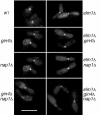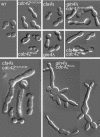Genetic interactions among regulators of septin organization
- PMID: 15302817
- PMCID: PMC500892
- DOI: 10.1128/EC.3.4.847-854.2004
Genetic interactions among regulators of septin organization
Abstract
Septins form a cortical scaffold at the yeast mother-bud neck that restricts the diffusion of cortical proteins between the mother and bud and serves as a signaling center that is important for governing various cell functions. After cell cycle commitment in late G(1), septins are assembled into a narrow ring at the future bud site, which spreads to form a mature septin hourglass immediately after bud emergence. Although several septin regulators have been identified, it is unclear how they cooperate to assemble the septin scaffold. We have examined septin localization in isogenic strains containing single or multiple mutations in eight septin organization genes (CDC42, RGA1, RGA2, BEM3, CLA4, GIN4, NAP1, and ELM1). Our results suggest that these regulators act largely in parallel to promote either the initial assembly of the septin ring (CDC42, RGA1, RGA2, BEM3, and CLA4) or the conversion of the ring to a stable hourglass structure at the neck (GIN4, NAP1, and ELM1). Aberrant septin localization patterns in mutant strains could be divided into apparently discrete categories, but individual strains displayed heterogeneous defects, and there was no clear-cut correspondence between the specific mutations and specific categories of defect. These findings suggest that when they are deprived of their normal regulators, septin scaffolds collapse into a limited repertoire of aberrant states in which the nature of the mutant regulators influences the probability of a given aberrant state.
Figures




Similar articles
-
Role of the septin ring in the asymmetric localization of proteins at the mother-bud neck in Saccharomyces cerevisiae.Mol Biol Cell. 2005 Aug;16(8):3455-66. doi: 10.1091/mbc.e04-09-0764. Epub 2005 May 18. Mol Biol Cell. 2005. PMID: 15901837 Free PMC article.
-
Interplay between septin organization, cell cycle and cell shape in yeast.J Cell Sci. 2005 Apr 15;118(Pt 8):1617-28. doi: 10.1242/jcs.02286. Epub 2005 Mar 22. J Cell Sci. 2005. PMID: 15784684
-
The Ccr4-Pop2-NOT mRNA deadenylase contributes to septin organization in Saccharomyces cerevisiae.Genetics. 2009 Aug;182(4):955-66. doi: 10.1534/genetics.109.104414. Epub 2009 Jun 1. Genetics. 2009. PMID: 19487562 Free PMC article.
-
Regulation of septin organization and function in yeast.Trends Cell Biol. 2003 Aug;13(8):403-9. doi: 10.1016/s0962-8924(03)00151-x. Trends Cell Biol. 2003. PMID: 12888292 Review.
-
Architecture, remodeling, and functions of the septin cytoskeleton.Cytoskeleton (Hoboken). 2019 Jan;76(1):7-14. doi: 10.1002/cm.21475. Epub 2018 Aug 2. Cytoskeleton (Hoboken). 2019. PMID: 29979831 Free PMC article. Review.
Cited by
-
Role of the septin ring in the asymmetric localization of proteins at the mother-bud neck in Saccharomyces cerevisiae.Mol Biol Cell. 2005 Aug;16(8):3455-66. doi: 10.1091/mbc.e04-09-0764. Epub 2005 May 18. Mol Biol Cell. 2005. PMID: 15901837 Free PMC article.
-
Some assembly required: yeast septins provide the instruction manual.Trends Cell Biol. 2005 Aug;15(8):414-24. doi: 10.1016/j.tcb.2005.06.007. Trends Cell Biol. 2005. PMID: 16009555 Free PMC article. Review.
-
Septin structure and function in yeast and beyond.Trends Cell Biol. 2011 Mar;21(3):141-8. doi: 10.1016/j.tcb.2010.11.006. Epub 2010 Dec 20. Trends Cell Biol. 2011. PMID: 21177106 Free PMC article. Review.
-
Regulation of septin dynamics by the Saccharomyces cerevisiae lysine acetyltransferase NuA4.PLoS One. 2011;6(10):e25336. doi: 10.1371/journal.pone.0025336. Epub 2011 Oct 3. PLoS One. 2011. PMID: 21984913 Free PMC article.
-
Reciprocal regulation by Elm1 and Gin4 controls septin hourglass assembly and remodeling.J Cell Biol. 2024 May 6;223(5):e202308143. doi: 10.1083/jcb.202308143. Epub 2024 Mar 5. J Cell Biol. 2024. PMID: 38448162 Free PMC article.
References
Publication types
MeSH terms
Substances
Grants and funding
LinkOut - more resources
Full Text Sources
Molecular Biology Databases
Miscellaneous

